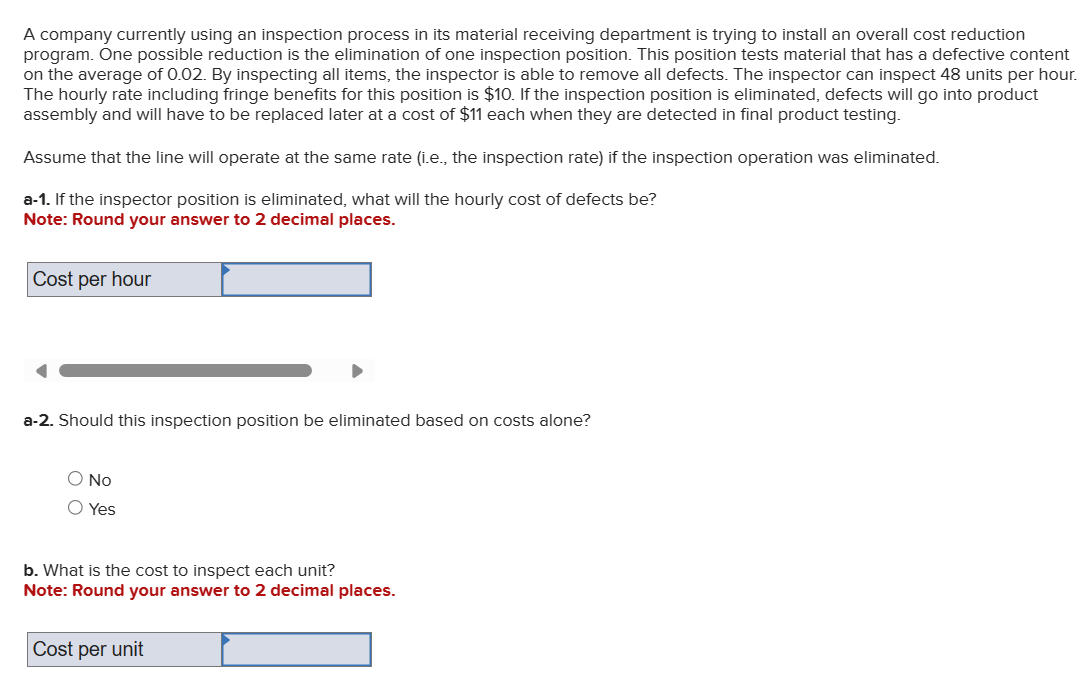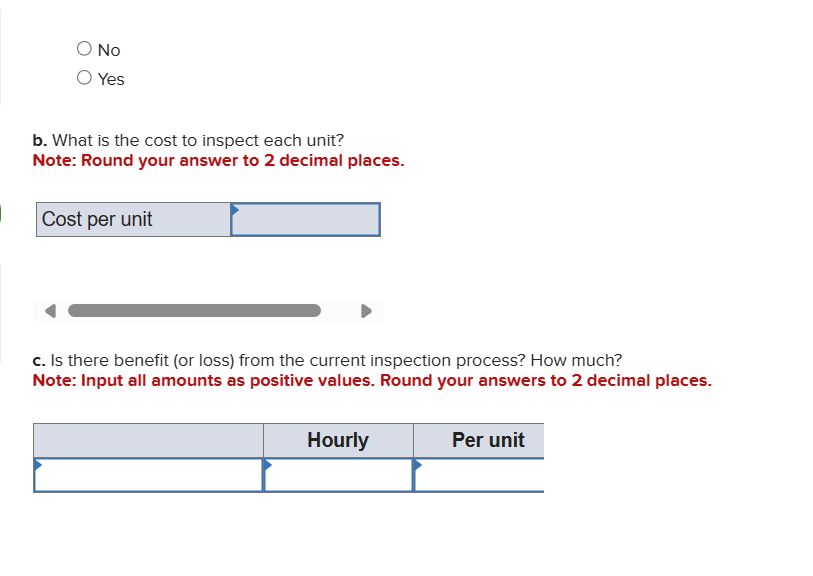A company currently using an inspection process in its material receiving department is trying to install an overall cost reduction program. One possible reduction is the elimination of one inspection position. This position tests material that has a defective content on the average of 0.02. By inspecting all items, the inspector is able to remove all defects. The inspector can inspect 48 units per hour. The hourly rate including fringe benefits for this position is $10. If the inspection position is eliminated, defects will go into product assembly and will have to be replaced later at a cost of $11 each when they are detected in final product testing. Assume that the line will operate at the same rate (i.e., the inspection rate) if the inspection operation was eliminated. a-1. If the inspector position is eliminated, what will the hourly cost of defects be? Note: Round your answer to 2 decimal places. Cost per hour a-2. Should this inspection position be eliminated based on costs alone? No Yes b. What is the cost to inspect each unit? Note: Round your answer to 2 decimal places. Cost per unit No ○ Yes b. What is the cost to inspect each unit? Note: Round your answer to 2 decimal places. Cost per unit c. Is there benefit (or loss) from the current inspection process? How much? Note: Input all amounts as positive values. Round your answers to 2 decimal places. Hourly Per unit
A company currently using an inspection process in its material receiving department is trying to install an overall cost reduction program. One possible reduction is the elimination of one inspection position. This position tests material that has a defective content on the average of 0.02. By inspecting all items, the inspector is able to remove all defects. The inspector can inspect 48 units per hour. The hourly rate including fringe benefits for this position is $10. If the inspection position is eliminated, defects will go into product assembly and will have to be replaced later at a cost of $11 each when they are detected in final product testing. Assume that the line will operate at the same rate (i.e., the inspection rate) if the inspection operation was eliminated. a-1. If the inspector position is eliminated, what will the hourly cost of defects be? Note: Round your answer to 2 decimal places. Cost per hour a-2. Should this inspection position be eliminated based on costs alone? No Yes b. What is the cost to inspect each unit? Note: Round your answer to 2 decimal places. Cost per unit No ○ Yes b. What is the cost to inspect each unit? Note: Round your answer to 2 decimal places. Cost per unit c. Is there benefit (or loss) from the current inspection process? How much? Note: Input all amounts as positive values. Round your answers to 2 decimal places. Hourly Per unit
Practical Management Science
6th Edition
ISBN:9781337406659
Author:WINSTON, Wayne L.
Publisher:WINSTON, Wayne L.
Chapter11: Simulation Models
Section11.4: Marketing Models
Problem 33P
Related questions
Question
PLease Help me !!!!!!!!!

Transcribed Image Text:A company currently using an inspection process in its material receiving department is trying to install an overall cost reduction
program. One possible reduction is the elimination of one inspection position. This position tests material that has a defective content
on the average of 0.02. By inspecting all items, the inspector is able to remove all defects. The inspector can inspect 48 units per hour.
The hourly rate including fringe benefits for this position is $10. If the inspection position is eliminated, defects will go into product
assembly and will have to be replaced later at a cost of $11 each when they are detected in final product testing.
Assume that the line will operate at the same rate (i.e., the inspection rate) if the inspection operation was eliminated.
a-1. If the inspector position is eliminated, what will the hourly cost of defects be?
Note: Round your answer to 2 decimal places.
Cost per hour
a-2. Should this inspection position be eliminated based on costs alone?
No
Yes
b. What is the cost to inspect each unit?
Note: Round your answer to 2 decimal places.
Cost per unit

Transcribed Image Text:No
○ Yes
b. What is the cost to inspect each unit?
Note: Round your answer to 2 decimal places.
Cost per unit
c. Is there benefit (or loss) from the current inspection process? How much?
Note: Input all amounts as positive values. Round your answers to 2 decimal places.
Hourly
Per unit
Expert Solution
This question has been solved!
Explore an expertly crafted, step-by-step solution for a thorough understanding of key concepts.
Step by step
Solved in 2 steps

Recommended textbooks for you

Practical Management Science
Operations Management
ISBN:
9781337406659
Author:
WINSTON, Wayne L.
Publisher:
Cengage,

Practical Management Science
Operations Management
ISBN:
9781337406659
Author:
WINSTON, Wayne L.
Publisher:
Cengage,